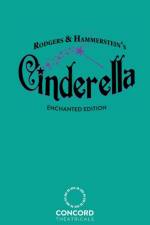von Richard Rodgers & Oscar Hammerstein
20,00 €
The timeless enchantment of a magical fairy tale is reborn with the Rodgers & Hammerstein hallmarks of originality, charm and elegance. Originally presented on television in 1957 starring Julie Andrews, Rodgers & Hammerstein's Cinderella was the most widely viewed program in the history of the medium. Its recreation in 1965 starring Lesley Ann Warren was no less successful in transporting a new generation to the miraculous kingdom of dreams-come-true, and so was a second remake in 1997, which starred Brandy as Cinderella and Whitney Houston as her Fairy Godmother. As adapted for the stage, with great warmth and more than a touch of hilarity, this romantic fairy tale still warms the hearts of children and adults alike. This Enchanted Edition is inspired by the 1997 teleplay.Rodgers and Hammerstein's Cinderella premiered in a live television broadcast on March 31, 1957, starring Julie Andrews, a sparkling new star who had just triumphed in My Fair Lady. Richard Lewine, a distant cousin and close friend of Rodgers, produced and Ralph Nelson directed. Real-life spouses Howard Lindsay and Dorothy Stickney played the King and Queen; Jon Cypher played the Prince; Ilka Chase, Kaye Ballard and Alice Ghostley played the comical Stepmother and Stepsisters; and Edi Adams played the Fairy Godmother.Rodgers and Hammerstein approached the story with the honesty and simplicity that characterized all their work, and Cinderella was a smash hit. The live broadcast was viewed by more people than any other program in the history of television.In 1997, Cinderella was remade for television in a production adapted by Robert L. Freedman and directed by Robert Iscove, with choreography by Rob Marshall. Produced by Whitney Houston and Debra Martin Chase for Walt Disney Television, Rodgers and Hammerstein's Cinderella aired on November 2, 1997. This version featured a diverse cast, with Brandy Norwood as Cinderella, Whitney Houston as her fairy godmother, Bernadette Peters as Cinderella's stepmother, Paolo Montalbán as the prince, Whoopi Goldberg as the queen, Victor Garber as the king and Jason Alexander as Lionel, the herald. Several songs were added, including "The Sweetest Sounds" from No Strings, sung by Cinderella and the Prince, and "There's Music in You," written for the 1953 film Main Street to Broadway, sung as the finale by the Fairy Godmother. Sixty million viewers watched the broadcast, making it the most-watched television musical in decades, and earning ABC its highest Sunday-night ratings in 10 years.



